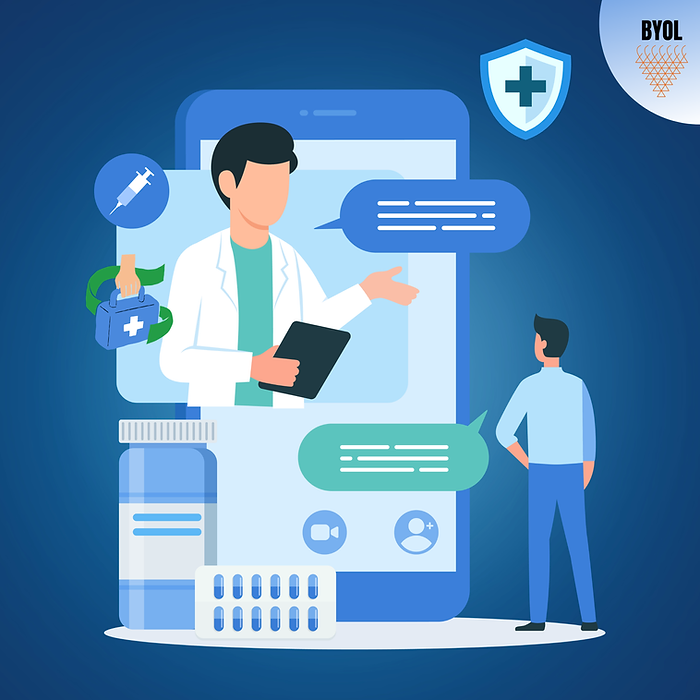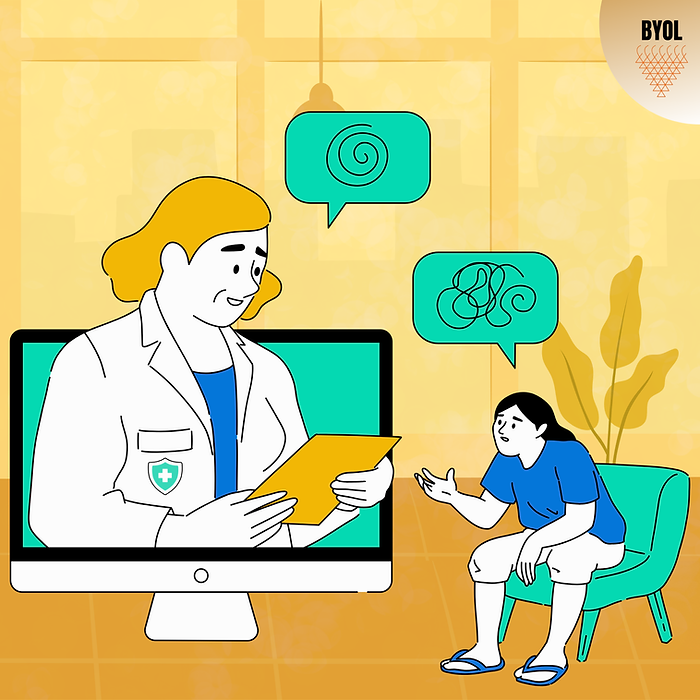Cancer biology has long focused on DNA mutations, changes in the genetic code that impair tumor suppressor genes or activate […]
Healing at Your Fingertips: The Rise of Telemedicine

Telemedicine is the application of information and communication technologies to enhance patient outcomes by maximizing access to healthcare and medical information. It is regarded as the tool for the remote diagnosis and treatment of patients through the use of technology. Indian Government has accepted the definition of telemedicine given by the World Health Organization (“WHO”), as “The delivery of health care services, where distance is a critical factor, by all health care professionals using information and communication technologies for the exchange of valid information for diagnosis, treatment and prevention of disease and injuries, research and evaluation, and for the continuing education of health care providers, all in the interests of advancing the health of individuals and their communities”.
Telemedicine can be used to enhance the availability of quality healthcare to all Indians, as India is plagued by a poor doctor to patient ratio where there is only one doctor available for every 1,445 Indians. This is interfering with the even delivery of healthcare services which has been one of the key objectives in public health administration for decades. The gap is even greater in the rural parts because most of the doctors are inclined to practice in the urban areas. The WHO carried out a study where it was revealed that 59.2% of all the health workers were found in urban areas, which have 27.8% of the total population, and 40.8% of all the health workers were found in rural areas, which have 72.2% of the total population. Telemedicine can facilitate the smoothing over of these disparities by allowing physicians in urban centers to consult the rural population, including offering specialized care as required.

Rise of Telemedicine in India
E-health solutions, in which telemedicine is included, are identified as cost-saving instruments to enhance the access to health care and improve patient outcomes. Telemedicine in India was initiated under the patronage of the Indian Space Research Organisation (ISRO) in the year 2001. Several telemedicine initiatives have been launched in various states of the nation in collaboration with Ministry of Electronics and Information Technology (MEITY) and Ministry of Health and Family Welfare (MoHFW). The National Health Policy-2017 had promoted widespread adoption of digital devices for enhancing the reach of the healthcare system. Telemedicine online consultation networks, such as the National Medical College Network (NMCN) and State telemedicine networks, were set up. Telemedicine guidelines for the Health and Wellness Centres (HWC) of the Ayushman Bharat Scheme were launched in 2019 to utilize Information Communication Technologies (ICT) to link the HCW with the Medical colleges.
The COVID-19 pandemic acted as a spur towards legitimisation and growth of telemedicine in India. The Telemedicine Practice Guidelines issued in 2020 ushered in clarity regarding the legal status of telemedicine in India. The Government of India has since actively included telemedicine in the public health delivery system through the eSanjeevani programs.

Key Elements of the Telemedicine Process
- Patient: The patient who needs Tele- consultation.
- Primary Doctor: The registered medical practitioner (RMP) having direct access to the Patient. The Primary Doctor will be present at the Telemedicine Consultancy Centre (TCC).
- Specialist: The registered medical practitioner providing medical consultation to the Patient from a distance. A Specialist is present at Telemedicine Specialty Centre (TSC).
- Telemedicine System: The technology/system developed to store, communicate and manage all the information/data of the patient e.g. the Electronic Medical Record (EMR) of the Patient to the Specialist, through TCC and TSC.
- Telemedicine Consultancy Centre (TCC): The medical centre where the patient is located. The TCC shall be provided with minimum technology needed for medical information exchange and medical consultation.
- Telemedicine Specialty Centre (TSC): The hospital where the Specialist is based. Similar to the TCC, this centre will have simple technology needed for sharing medical information and medical consultation. Tele-consultancy will be given by the specialist from the TSC.
- Tele-consultation: The provision of health care services via information and communication technology from a distance.
Modes of Communication
- Consultation over Telemedicine PlatformVarious telemedicine platforms have been introduced in recent years and are typically established in the shape of website or mobile apps. The platform brings patients in touch with Health Care Personnel (HCP) where consultation is done over an app-integrated calling or messaging service. The platform can either give the patients a list of physicians present on the platform and allow the patient to select the HCP with whom they want to speak or directly pair the patient with the target HCP. On conclusion of the consultation, the HCP can send the prescription online through the telemedicine platform based on which the patient can buy the required medicines. Alternatively, the HCP can also request the patient to undergo certain tests in order to be able to diagnose correctly the underlying medical condition.
- Consultation via a Messaging PlatformPatients and HCPs usually consult informally via general messaging applications. The messaging applications differ from telemedicine platforms since they are not designed specifically for offering medical consultation or the processing and collection of health information. The consultation could be initiated by a patient through initiating contact with the HCP and could occur via text messaging, call or video facilities offered by the messaging application. The HCP can, at the end of the consultation, send an online prescription via the messaging application on the basis of which the patient can buy the necessary drugs. The HCP can also instruct the patient to undergo certain tests so that they can effectively diagnose the underlying health condition.
- Physician to Physician consultationsAs the name implies, these consultations are between two doctors where one doctor (treating doctor/referring doctor) refers a specialist for advice on a patient under the treating doctor’s care. These consultations occur informally where the treating doctor shares patient details with the specialist in order to get the specialist’s opinions on the diagnosis or the treatment. The expert does not normally deal with the patient themselves and any guidance that comes from the expert is passed on to the patient by the physician.
- Cross-Border ConsultationsCross-border consultations are a subset of physician-to-physician consultations. Cross-border consultations can occur in two forms:i). A doctor qualified to practice in India examines medical data of a patient overseas on the basis of a referral by an overseas physician. The overseas physician will be the referring/treating doctor while the Indian doctor will be the specialist. The expert gives medical recommendations to either directly to the patient (depending on whether the laws in the country of the patient allow this) or gives their professional opinion to the treating doctor who finally approves the treatment plan of the patient.ii). An Indian doctor who is licensed to practice in India refers a foreign doctor on a particular case. Here, the Indian doctor is the referring/treating doctor and the foreign doctor is the specialist. The foreign doctor reads the medical information presented and advises what needs to be done. The Indian doctor finally signs off on the advice as the treating doctor.
Telemedicine Practice Guidelines (TPGs)
The TPGs were published in March 2020 to issue guidelines to HCPs for the practice of telemedicine during the COVID-19 pandemic. The practice of telemedicine had been regulated in an ad-hoc manner under relevant provisions of the Indian Medical Council Act,1956, Medical Council of India Code and the Information Technology Act, 2000 before the TPGs were issued. The declared intent behind the guidelines is to help the medical practitioner pursue an appropriate course of action to offer effective and safe medical care based on up-to-date information, resources available and patient requirements in order to provide patient and provider safety. Consistent with the above, the TPG grants a broad margin of discretion to the HCP to decide the proper course of action while consulting patients through telemedicine. Currently, the TPG are only enforceable against a registered medical practitioner (“RMP”) i.e. an individual registered to practice with a state medical council under the provisions of the National Medical Council Act.
TPGs do not cover dentists or practitioners of Indian systems of medicine e.g. Ayurveda, Unani, Siddha and Homeopathy. It is to be mentioned that the Central Council of Indian Medicine (the regulatory body for practitioners of Ayurveda, Unani and Siddha) has issued a different set of guidelines governing practice of telemedicine by Ayurveda, Siddha and Unani practitioners. Since the TPG is only binding for RMPs, other telemedicine stakeholders like patients, telemedicine platforms, messaging apps, insurance companies etc. are not obligated by these guidelines.
Key features of the TPGs
- Legal recognition to telemedicine practiceThe TPG clearly mentions that an RMP is entitled to offer telemedicine consultations from anywhere in India.
- Excludes non-teleconsultation aspects of Telemedicine specificallyThe TPG excludes the following specifically from its purview:i. Hardware or software specifications, building and maintenance of infrastructure.ii. Data management systems involved, including standards and interoperability of such systems.iii. Application of digital technologies for the performance of surgical or invasive procedures from a distance.iv. Other dimensions of telehealth like research and assessment, and ongoing education of healthcare providers.v. Consultations falling outside India’s jurisdiction.
- Types of telemedicine consultationThe TPG categorizes telemedicine consultations into the various types on the basis of mode of consultation, timing of information transmitted, the purposes of consultation and the individual to whom advice is delivered (patient, caretaker or RMP). Every type of teleconsultation is again sub-divided in the following categories:i) Mode of Consultationa) Videob) Audioc) Textii) Timing of Informationa) Real-timeb) Asynchronousiii) Purpose of Consultationa) First Consultb) Follow up Consultc) Emergency Consultiv) Person to Whom Advice Provideda) RMP to Patientb) RMP to Caregiverc) RMP to RMPd) RMP to Health worker
- Circumstances in which telemedicine is allowedThe choice to consult through telemedicine should be made after considering the following factors:i. The mode/technology for consultation available.ii. The complexity of the patient’s condition.iii. In emergency conditions, the RMP can provide tele-consultation if this is the only way of delivering timely care.
- Identification of patient and RMP before consultationThe TPG forbids anonymous consultation on the part of both the patient and the RMP. Every individual must give the following information at the beginning of the consultation.Patienti. Name ii. Age iii. Address iv. Email v. Phone Number vi. Registration IDRMPi. Name ii. Qualifications iii. Registration Number issued under the NMC Act
- Consultation to minorsThe RMP must determine the patient’s age at the beginning of the teleconsultation. If the patient is a minor, consultation must be conducted in front of an adult whose identity must be confirmed as per the parameters mentioned above.
- Patient consentThe method of obtaining the consent of the patient varies with whether the teleconsultation has been initiated by the patient, caregiver or the RMP. If the teleconsultation has been initiated by the patient, the consent is implied. If the teleconsultation has been initiated by the caregiver, health worker or an RMP, the patient’s explicit consent must be documented. The documentation may be done in the form of an email, text, audio/video message.
- Prescribing medicinesThe TPG has specific provisions on what medicines can be prescribed in particular situations as follows.Outcome of Telemedicine ConsultationsWhere the RMP is of the opinion that the medical condition could be managed suitably through telemedicine, the RMP may go ahead with any (or all) of the following.i. Provide Health Educationii. Counsellingiii. Prescribing medicinesManner of Prescribing MedicinesThe TPG puts restrictions on the prescription of some medicines based on the facts and circumstances of a case. The types of medicines that can be prescribed through telemedicine would be notified by the government from time to time. Till date no list has been notified.Maintenance of RecordsIt is obligatory on the part of the RMP to keep the following records for teleconsultationi. Telemedicine interaction log i.e. telephone logs, emails, chat/text log, video interaction logs etc.ii. Patient reports, documents, images, diagnostics, data etc. (digital or non-digital) used for the telemedicine consultation.iii) If any prescription is forwarded to the patient, the RMP needs to keep the records of the prescription as is for the case of physical consultations.
Future of Telemedicine
- Telemedicine is a fairly recent idea in its early stages of use. The swift development in telecommunication technologies makes the assessment of effectiveness of telemedicine an arduous task requiring continuous updating of the major hardware and software.
- Most telemedicine applications rely on technical and human infrastructures that are complicated, incomplete, and occasionally cumbersome. Until those infrastructures become more widespread and friendly to use (e.g., flexible, simple-to-use work-stations situated where clinicians are working), analyses of costs and acceptability will frequently be frustrating to advocates for the programs and applications relying on this shared infrastructure.
- Delivering or enabling medical treatment at a distance can involve an unprecedented degree of collaboration between institutions and individuals who are not held together by shared organizational membership and governance structure.
- The TPG form a solid basis upon which to more fully regulate telemedicine in the future. The TPG were released to provide clarity to the telemedicine process during the COVID19 pandemic and have done a commendable job of clarifying some of the legal uncertainties surrounding the status of telemedicine and setting out a template for how teleconsultations are to be carried out. That aside, there is scope to widen the ambit of the TPGs and to introduce amendments to further consolidate the telemedicine regulations in India.
References
- Ministry of Health and Family Welfare. E- Governance and Telemedicine in: Annual Report of Department of Health and Family Welfare 2017-18 [Internet]. New Delhi; 2018. Available from: https://main.mohfw.gov.in/sites/default/files/20 Chapter.pdf
- Indian Space Research Organization. Telemedicine Healing Touch Through SpaceEnabling Specialty Healthcare to the Rural and Remote Population of India [Internet]. Available from: http://www.televital.com/downloads/ISRO-TelemedicineInitiative.pdf
- Chellaiyan V, Nirupama A, Taneja N. Telemedicine in India: Where do we stand? J Fam Med Prim Care [Internet]. 2019 8(6):1872.
- Dasgupta A, Deb S. Telemedicine: A new horizon in public health in India. Indian J Community Med [Internet]. 2008;33(1):3.
- Ministry of Health and Family Welfare. The National Health Policy 2017- Executive Summary [Internet]. New Delhi; 2017. Available from: https:// www.nhp.gov.in / nhpfiles /national_health_policy_2017.pdf
- Ministry of Health and Family Welfare. Telemedicine Practice Guidelines [Internet]. New Delhi; 2020 Mar. Available from: https://www.mohfw.gov.in /pdf/Telemedicine.pdf
- Strehle EM, Shabde N. One hundred years of telemedicine: Does this new technology have a place in paediatrics? Vol. 91, Archives of Disease in Childhood. BMJ Publishing Group; 2006. p. 956–9


